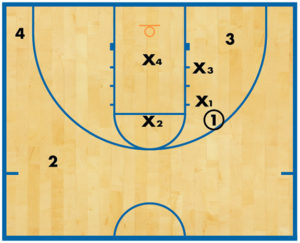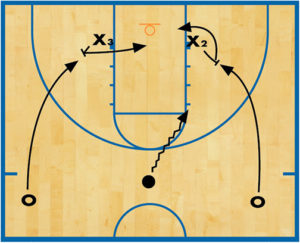Success in transition game comes from drilling it in practice
Whether your team is fast or slow, you need to try to push the ball and use the transition game as much as possible. The majority of teams (especially in high school) are weak when it comes to transition defense. Your players need to work on the skills necessary to become a transition team. It’s not simply outsprinting the opposition. Timing, spacing and quick thinking fuel a successful fast-breaking team.
The easiest drill to start with is a full-court break that everyone runs.
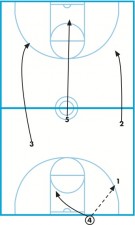 DIAGRAM 1: Full-court, fast-break drill. Always have 4 take the ball out of bounds. This keeps things simple. 4 passes to 1. 1 has the option of hitting 3, 5 or 2 in stride while they are running down the court.
DIAGRAM 1: Full-court, fast-break drill. Always have 4 take the ball out of bounds. This keeps things simple. 4 passes to 1. 1 has the option of hitting 3, 5 or 2 in stride while they are running down the court.
Or, he or she attacks the circle on the dribble, then finds the open player to get rid of the ball. 4 always trails opposite of 1 and 5 always runs to the ball-side post.
Post-player break drills
The following drills should be completed on both sides of the floor. Use coaches as passers if possible. If not, players are managers are fine.
 DIAGRAM 2: Quick-outlet drill. The goal is to get the ball out of the net and into play as quickly as possible. To accomplish this, players need to learn to step out of bounds with one foot while keeping the other foot in the air inbounds (right foot steps out on the right side and vice versa). The player taking the ball out of bounds must use a two-handed pass. The two-handed pass allows the passer to pull the ball back into his or her body if the outlet person is covered. In this drill, 1 shoots a layup, with 2 following, grabbing the ball, stepping out of bounds with one foot and firing a two-handed chest pass to the player waiting on the wing.
DIAGRAM 2: Quick-outlet drill. The goal is to get the ball out of the net and into play as quickly as possible. To accomplish this, players need to learn to step out of bounds with one foot while keeping the other foot in the air inbounds (right foot steps out on the right side and vice versa). The player taking the ball out of bounds must use a two-handed pass. The two-handed pass allows the passer to pull the ball back into his or her body if the outlet person is covered. In this drill, 1 shoots a layup, with 2 following, grabbing the ball, stepping out of bounds with one foot and firing a two-handed chest pass to the player waiting on the wing.
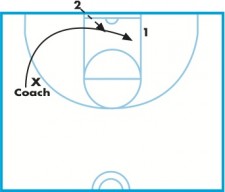
DIAGRAM 3: Quick-outlet-look drill. While the outlet player needs to be fast, this doesn’t mean he is careless. Adding a “look” to the Quick-Outlet Drill means placing a defender on the player (coach) who is set to receive the outlet pass. If the defender denies the coach, then he or she needs to make a move to get open. Teach players to get low and attack the defender’s inside shoulder while looping around. The denial keeps the passer from slinging the ball into play.
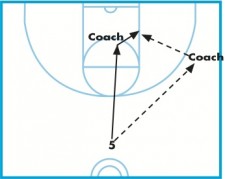 DIAGRAM 4: Run-and-post drill. A post player passes to the wing, then sprints to the front of the rim and hits the closest defender (played by a coach with a football pad) to him or her to gain initial position. The coach hits him hard. The wing then passes to the post player who makes a designated post move.
DIAGRAM 4: Run-and-post drill. A post player passes to the wing, then sprints to the front of the rim and hits the closest defender (played by a coach with a football pad) to him or her to gain initial position. The coach hits him hard. The wing then passes to the post player who makes a designated post move.
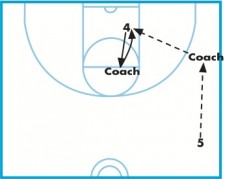
DIAGRAM 5: Initiate-contact drill. This drill simulates when a big player beats both the player and the ball down the court. The wing passes the ball to the coach. The big player under the hoop initiates contact with another coach holding a football pad at the free throw line. The big player then shifts back into the lane, receives the pass and makes a power layup.
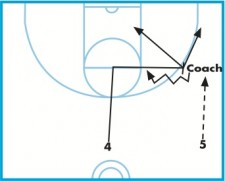 DIAGRAM 6: Ball-screen drill. Your big players should be able to set ball screens on the wing in transition. In this drill a wing passes to the coach. The big player at mid-court then sprints to the free-throw area, then runs out to set a ball screen for the coach. The coach dribbles to the left while the big player either rolls to the hoop for a pass and layup or pops to the outside for a catch and shot.
DIAGRAM 6: Ball-screen drill. Your big players should be able to set ball screens on the wing in transition. In this drill a wing passes to the coach. The big player at mid-court then sprints to the free-throw area, then runs out to set a ball screen for the coach. The coach dribbles to the left while the big player either rolls to the hoop for a pass and layup or pops to the outside for a catch and shot.
 DIAGRAM 7: Ball-Screen-For-Point Drill. If the point guard can’t advance the ball with a pass, he or she needs a screen from a big player. In this drill the coach dribbles up the floor. The big player trails, then sets a screen for the coach. The big player rolls to the hoop or pops to the outside for a shot.
DIAGRAM 7: Ball-Screen-For-Point Drill. If the point guard can’t advance the ball with a pass, he or she needs a screen from a big player. In this drill the coach dribbles up the floor. The big player trails, then sets a screen for the coach. The big player rolls to the hoop or pops to the outside for a shot.
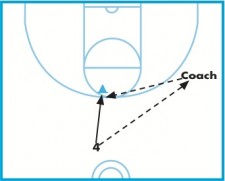 DIAGRAM 8: Stretch-the-defense drill. A big player who shoots the long-range shot well stretches the defense. In this drill, the big player passes to the coach, then advances to the 3-point area. The coach passes back to the big player, who has a few options, including: a jump stop off the catch (leaving both pivot feet available); rip through right or left; shot fake and drive right or left; or jab step off either the right or left foot. All of these moves sets up an open look for the big player. Have him or her take the long-range shot.
DIAGRAM 8: Stretch-the-defense drill. A big player who shoots the long-range shot well stretches the defense. In this drill, the big player passes to the coach, then advances to the 3-point area. The coach passes back to the big player, who has a few options, including: a jump stop off the catch (leaving both pivot feet available); rip through right or left; shot fake and drive right or left; or jab step off either the right or left foot. All of these moves sets up an open look for the big player. Have him or her take the long-range shot.
Guard break drills
These drills are designed to make your guards better in transition.
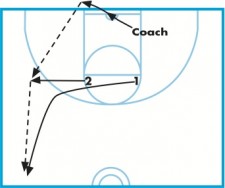 DIAGRAM 9: Quick-outlet drill. The coach shoots, gets the rebound and quickly takes the ball out of bounds. Your two guards then hurry to get into their positions. The coach passes to 2 who catches the ball and looks up the court. 2 is allowed one dribble then he or she must pass to 1 who is heading up the court. Teach 2 to scream “Outlet!” so the inbounding player knows how should receive the pass — this is a critical skill to develop for game situations.
DIAGRAM 9: Quick-outlet drill. The coach shoots, gets the rebound and quickly takes the ball out of bounds. Your two guards then hurry to get into their positions. The coach passes to 2 who catches the ball and looks up the court. 2 is allowed one dribble then he or she must pass to 1 who is heading up the court. Teach 2 to scream “Outlet!” so the inbounding player knows how should receive the pass — this is a critical skill to develop for game situations.
 DIAGRAM 10: Beat-the-denial drill. 1 is positioned on the wing to receive the outlet pass. S is positioned close to him but out of bounds. X is allowed to enter the court whenever he or she wishes. 2 is positioned up the floor near the mid-court circle on the ball side. When X enters the court, he or she denies an inbound pass to 1. 1 then gets low, attacks X’s shoulder and loops around. The coach passes to 1 who attacks the middle of the court, then only is allowed two dribbles before outletting to 2.
DIAGRAM 10: Beat-the-denial drill. 1 is positioned on the wing to receive the outlet pass. S is positioned close to him but out of bounds. X is allowed to enter the court whenever he or she wishes. 2 is positioned up the floor near the mid-court circle on the ball side. When X enters the court, he or she denies an inbound pass to 1. 1 then gets low, attacks X’s shoulder and loops around. The coach passes to 1 who attacks the middle of the court, then only is allowed two dribbles before outletting to 2.
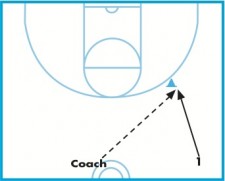 DIAGRAM 11: Attack drill. The coach is positioned near mid-court. Your guard is to his far right. A cone is placed on the guard’s side of the court near the 3-point line. The guard runs hard to the cone and receives a pass from the coach. He or she catches the ball and makes a jump stop. His or her options now include: shooting the 3-pointer; ripping through to the middle or baseline; jab stepping with the right or left foot; shot faking then going middle or baseline; driving to the middle and passing to the weak side; or driving baseline and passing to the weak side.
DIAGRAM 11: Attack drill. The coach is positioned near mid-court. Your guard is to his far right. A cone is placed on the guard’s side of the court near the 3-point line. The guard runs hard to the cone and receives a pass from the coach. He or she catches the ball and makes a jump stop. His or her options now include: shooting the 3-pointer; ripping through to the middle or baseline; jab stepping with the right or left foot; shot faking then going middle or baseline; driving to the middle and passing to the weak side; or driving baseline and passing to the weak side.
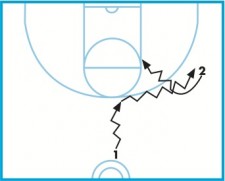 DIAGRAM 12: Dribble-handoff drill. The point guard dribbles to the top of the key, then to the right. To the right is a wing player, who cuts behind him or her. The two execute a dribble hand off with the wing player doing any of the following: dribbling all the way to the basket; shooting a 15-foot jumper from the elbow; getting to the middle and passing to the weak side; or passing it back to the point guard.
DIAGRAM 12: Dribble-handoff drill. The point guard dribbles to the top of the key, then to the right. To the right is a wing player, who cuts behind him or her. The two execute a dribble hand off with the wing player doing any of the following: dribbling all the way to the basket; shooting a 15-foot jumper from the elbow; getting to the middle and passing to the weak side; or passing it back to the point guard.
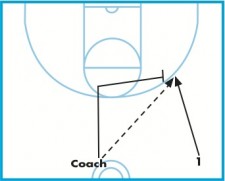 DIAGRAM 13: Pick-and-roll drill. The coach passes to the player on the wing, who has moved from mid-court to the 3-point line. The coach then comes over and sets a pick for the guard. The two operate a standard pick-and-roll play. The coach tells the guard what the defensive read is (under, hard show, switch, trap, slow show, etc.) and the guard decides what is the best method of attack — dribbling, shooting, faking or passing.
DIAGRAM 13: Pick-and-roll drill. The coach passes to the player on the wing, who has moved from mid-court to the 3-point line. The coach then comes over and sets a pick for the guard. The two operate a standard pick-and-roll play. The coach tells the guard what the defensive read is (under, hard show, switch, trap, slow show, etc.) and the guard decides what is the best method of attack — dribbling, shooting, faking or passing.
Full-court transition drills
All of the following drills stress that offensive rebounds are easiest to secure when in transition. Most teams don’t box out well in a transition setting as almost every defender turns his or her head and watches the ball.
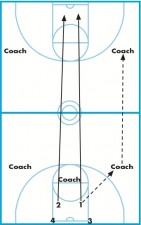
DIAGRAM 14: Offensive-rebound drill (A). Two rebounders position themselves in the lane. A coach at the free-throw line takes a shot. Whichever rebounder grabs the rebound, then outlets to the coach on his side of the floor. Both rebounders then sprint to the other end of the court. The coach with the ball then passes up the court to another coach on the wing. That coach takes a shot and one of the two rebounders must secure the rebound prior to the ball hitting the floor. Once a player has the rebound, he or she goes right up and tries to score.
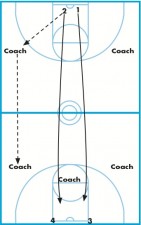 DIAGRAM 15: Offensive-rebound drill (B). After the second shot, whoever get the ball out of the net outlets to the coach on his or her side of the floor and the drills starts all over again heading back to the original end of the court.
DIAGRAM 15: Offensive-rebound drill (B). After the second shot, whoever get the ball out of the net outlets to the coach on his or her side of the floor and the drills starts all over again heading back to the original end of the court.
 DIAGRAM 16: Pitch-ahead drill (A). 1 throws the ball off the glass and grabs the rebound. 2 can’t break down the floor until 1 has the ball in his hands. 1 is allowed no more than two dribbles, then he or she pitches the ball ahead to 2 as 2 runs up the court. 2 must yell 1’s name to let him or her know he or she is open. After 1 passes the ball, he or she sprints the floor because he or she is now the rebounder on the other end (he cannot let the ball hit the floor on the rebound). 2 shoots a layup and 1 grabs the rebound — 1 also has the option of tipping in the missed shot.
DIAGRAM 16: Pitch-ahead drill (A). 1 throws the ball off the glass and grabs the rebound. 2 can’t break down the floor until 1 has the ball in his hands. 1 is allowed no more than two dribbles, then he or she pitches the ball ahead to 2 as 2 runs up the court. 2 must yell 1’s name to let him or her know he or she is open. After 1 passes the ball, he or she sprints the floor because he or she is now the rebounder on the other end (he cannot let the ball hit the floor on the rebound). 2 shoots a layup and 1 grabs the rebound — 1 also has the option of tipping in the missed shot.
 DIAGRAM 17: Pitch-ahead drill (B). 2 makes the layup at the end of Diagram 16. 1 grabs the ball out of the net, steps out of bounds (like described earlier with just one foot) and passes the ball into 2. 2, after his or her made layup, breaks to the outlet spot and yells “Outlet!”. He or she receives the pass from 1. Now, the player only may take two dribbles before throwing the ball ahead to the coach. 2 becomes the rebounder. 1 sprints to the other end of the court and receives a pass from the coach. 1 takes the short shot and 2 must rebound without allowing the ball to hit the floor. He or she is allowed to tip in the shot.
DIAGRAM 17: Pitch-ahead drill (B). 2 makes the layup at the end of Diagram 16. 1 grabs the ball out of the net, steps out of bounds (like described earlier with just one foot) and passes the ball into 2. 2, after his or her made layup, breaks to the outlet spot and yells “Outlet!”. He or she receives the pass from 1. Now, the player only may take two dribbles before throwing the ball ahead to the coach. 2 becomes the rebounder. 1 sprints to the other end of the court and receives a pass from the coach. 1 takes the short shot and 2 must rebound without allowing the ball to hit the floor. He or she is allowed to tip in the shot.

